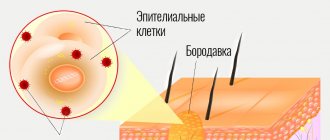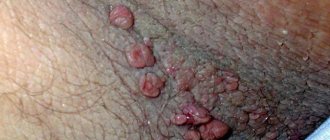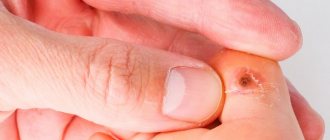Why do vaginal papillomas occur?
The main cause of papilloma in the vagina is the papilloma virus. It enters the body through unprotected sexual contact with a carrier. However, there are a number of factors that increase the likelihood of infection. These include sexually transmitted diseases (for example, gonorrhea and chlamydia).
Also, the reasons that contribute to the development of papillomas are:
- frequent change of sexual partners;
- disruption of the normal vaginal microflora (dysbiosis);
- low immunity;
- inflammation of the ovaries;
- severe stressful situations;
- pregnancy;
- deviations from the endocrine system;
- lack of vitamins in the body.
If several of the reasons described above are present, the risk of infection increases significantly. The incubation period is no more than 3 months, but under the influence of unfavorable circumstances for the immune system, this time can be reduced to 14-20 days.
Childbirth with condylomatosis
I would like to remind you that condylomas themselves are a manifestation of the human papillomavirus (HPV). This virus may pose a risk of fetal infection and laryngeal papillomatosis in the unborn child. Research does not confirm that 100% of women who carry the virus become infected in the fetus. Unfortunately, it is impossible to predict whether a child will become infected with the virus during pregnancy and childbirth. Undoubtedly, the presence of condylomas increases the risk of infection, so it is better to remove the tumors.
The need for delivery by cesarean section in women with condylomatosis is decided individually. It is preferable to give birth on your own, even despite the presence of formations in the area of the external or internal genital organs that are present before childbirth. There are cases that children born by cesarean section from pregnant women with HPV carriage suffer from laryngeal papillomatosis. Caesarean section is performed on pregnant women in the presence of extensive condylomatosis of the external genitalia, when this prevents vaginal delivery, or in combination with other complications and diseases during pregnancy.
It should be noted that termination of pregnancy for condylomatosis of the anogenital area is usually not performed.
Condylomas in the rectum (anus) area
Anal condylomas, like other types of similar neoplasms, are the result of infection of the body with the human papillomavirus. Condylomas in the anus are a rather complex disease, which is accompanied by the following symptoms:
- the appearance of a formation in the anus;
- an increase in the number of warts in this area;
- traumatization of warts due to mechanical impact.
Condylomas of the rectum must be treated without fail. A specialized doctor who is able to correctly diagnose this disease is a proctologist. As soon as you experience one of the above unpleasant sensations, you should immediately consult a doctor. Condylomas in the anal area are also called perianal by experts.
Papillomavirus is transmitted through sexual intercourse. In this case, anal sex plays a role.
What do condylomas look like?
The formation of growths in the intimate area is a common reason for girls to make an appointment with a gynecologist. Papillomas on the labia are small white growths. Vaginal papillomas can be of 2 types: exophytic and endophytic. The former are characterized by a papillary surface and a pointed shape; they are localized in the superficial layer. As a rule, they are provoked by HPV with a fairly low level of oncogenic activity. The latter are flat, they usually grow deep into the epithelial tissue and can cause pathologies in healthy tissue.
If such condylomas are not treated in time, the risk of developing cancer increases.
How much does it cost to remove condyloma
| Consultation with a dermatologist on the day of genital wart removal using a dermatoscope up to 2 units. | 1200 RUR Sign up |
| Laser removal of genital warts, for 1 unit. | 700 RUR Sign up |
| Laser removal of multiple genital warts, session 20 min. | 4000 RUR Sign up |
| Laser removal of multiple genital warts, session 30 min. | 5000 RUR Sign up |
| Laser removal of multiple genital warts, session 40 min. | 6000 RUR Sign up |
| Laser removal of condylomas up to 3 mm, including consultation with a dermatologist, dermatoscopy and anesthesia, 3-6 pcs. | 2800 RUR Sign up |
| Laser removal of condylomas up to 3 mm, including consultation with a dermatologist, dermatoscopy and anesthesia, 7-12 pcs. | 3200 RUR Sign up |
| Radio wave removal with kandil 1 unit - 20 min - price per unit. | 800 RUR Sign up |
| Radio wave removal with kandil 3-9 units - 20 min - price per unit | 500 RUR Sign up |
| Radio wave removal with kandil 10-20 units - 30 min - price per unit. | 400 RUR Sign up |
Show all prices
Symptoms of vaginal papilloma
The virus infection scheme is as follows: first, the pathogen enters the dermis layer, affecting the membrane of healthy cells, then the infected DNA is introduced into the cell, after which the virus waits for favorable conditions for activation. In this situation, if the infected girl has a strong immune system, papillomas in the vagina may not form for a long time. In total, there are 3 stages of the disease. The first is characterized by the absence of pronounced symptoms. Depending on the general physical condition and the state of the immune system, this stage can occur over a long period of time, and in the absence of provoking causes, symptoms may not appear for several years. Despite this, the girl is already a carrier of the virus and can infect her sexual partner.
The second stage is characterized by changes in the mucous membrane of the genital organs. Neoplasms can be localized deep in the vagina, so it is not possible to identify them independently. Papillomas at the entrance to the vagina or on the labia can sometimes be detected by touch. Also, due to regular contact with clothing or during washing, they may bleed, which is a serious reason to consult a doctor.
- the appearance of severe pain during sexual intercourse;
- itching and burning in the intimate area;
- the appearance of purulent discharge.
Many girls are interested in what papillomas in the vagina look like. Unfortunately, you won’t be able to detect these growths on your own; to do this, you need to undergo a thorough diagnostic examination.
Advantages and disadvantages of methods for removing genital papillomas
Each of the existing methods has its own advantages and disadvantages. Before choosing the appropriate method for removing genital warts, the patient and the doctor should analyze the pros and cons of surgical methods:
- Surgical removal of condylomas is a simple treatment method that does not require the use of complex equipment or highly qualified specialists. This technique is effective for removing large genital warts, has a low cosmetic effect and a long rehabilitation period;
- Electrocoagulation of condylomas is optimal for removing small, recently formed papillomas. Cauterization of genital warts is more often used when the malignancy of the neoplasm is suspected;
- Removal of condylomas by cryotherapy is an effective and affordable method of treating genital papillomas, characterized by a good cosmetic effect, minimal risk of scarring and the appearance of a postoperative blister, which can cause discomfort to a person. The disadvantages of removing genital warts with liquid nitrogen include the fact that it is not always possible to achieve good results the first time. Incorrectly selected intensity and depth of exposure may lead to the need to repeat the procedure;
- Laser excision of genital warts is an effective painless method of combating papillomas, which is characterized by a minimal number of postoperative complications and relapses, as well as high cosmetic results. However, carrying out the procedure requires professionalism and advanced equipment from the specialist;
Radio wave treatment of genital papillomas is a delicate and precise method of exposure that ensures minimal damage to healthy tissue by regulating the intensity and direction of radio wave radiation. The method of removing genital warts allows you to get rid of not only single and small growths, but also multiple, large tumors. The disadvantage of radio wave treatment of genital papillomas is considered to be a large list of contraindications.
Regardless of which method of surgical removal of genital warts is used, the procedure is followed by a rehabilitation period, during which it is necessary to adhere to the recommendations of the treating doctor (abstinence from intimacy, refusal to use tampons, vaginal suppositories, douching). Strict adherence to the listed rules will not only speed up the healing of the postoperative wound, but also prevent the development of consequences.
You can remove condylomas using any of the existing methods in our clinic. We employ experienced specialists who will not only select the appropriate method for removing genital warts, but will also carry out safe excision of any skin tumors.
Attention!
This article is posted for informational purposes only and under no circumstances constitutes scientific material or medical advice and should not serve as a substitute for an in-person consultation with a professional physician.
For diagnostics, diagnosis and treatment, contact qualified doctors! Number of reads: 820 Date of publication: 08/31/2018
Dermatologists - search service and appointment with dermatologists in Moscow
Diagnostics
If the above symptoms appear, it is recommended to promptly seek help from a gynecologist. To detect papillomas inside the vagina, the doctor will collect anamnesis and send the patient for further diagnostics (laboratory and instrumental). The medical history includes the collection of information about possible unprotected sexual intercourse, the approximate time of formation of growths, and other disturbing symptoms.
Further diagnostics consists of the following activities:
- linked immunosorbent assay. It is used to determine the presence of antibodies to the virus in the patient. This allows you to determine the degree of progression of HPV;
- PCR (polymerase chain reaction) analysis. It allows you to establish not only the presence, but also the quantity and type of pathogen present in the body;
- histological analysis. This diagnostic method is aimed at determining changes in the structure of vaginal tissue;
- colposcopy. Using a special device, the doctor examines the vagina and cervix to determine the affected areas;
- anoscopy. This method involves examining the patient’s anal area for the presence of papillomas;
- oncocytology. The specialist takes scrapings from the cervix and cervical canal and examines them in the laboratory.
Based on the diagnostic examination data, the doctor determines or denies the presence of papillomavirus infection. If a virus is detected, the patient is immediately prescribed treatment. During the growth of condylomas in the vagina, the virus is not contagious. The risk of infection appears when the pathogen reaches the epidermis.
Surgical excision of condylomas
Due to possible complications and a long rehabilitation period, traditional excision of genital warts using a scalpel is rarely used. But this method is effective with large condylomas. Also, the method of surgical removal of genital papillomas is indicated in cases where other methods of treating condylomas have not given the desired effect or cannot be used for certain reasons.
Surgical removal of condylomas involves excision of the pathological neoplasm using a scalpel, followed by suturing. During surgery, damage to healthy surrounding tissue occurs, which can lead to infection of the postoperative wound, as well as bleeding during and after the intervention. The procedure is performed under local anesthesia.
Removing large condylomas using a scalpel is a simple method that does not require highly qualified specialists. The disadvantage of the technique is the painful recovery period. There is a risk of bacterial infection, inflammation of the postoperative wound, scar formation. To relieve pain and prevent complications, the patient may be prescribed painkillers and antibacterial drugs.
Treatment methods
The papilloma virus is one of the most common infections, so girls often ask doctors: “How to treat papillomas localized in the vagina?” The essence of the treatment is aimed at blocking viral activity and restoring the body's protective functions. Depending on the degree of progression of the papilloma virus, doctors prescribe conservative or surgical treatment. Let's take a closer look at each method separately.
Drug therapy
Most often, medications are used to treat papilloma in the vagina. To do this, doctors prescribe antiviral drugs, for example, Alpisarin tablets, which can cope with rashes in the vaginal area in a short time. To avoid the transition of papilloma to a malignant neoplasm, inducers of interferon production, for example, Neovir, may be required. Along with drugs that have an antiviral effect, the patient requires immunomodulators, for example, Cycloferon. These remedies help the body resist penetrating infections. It is worth noting that these drugs are contraindicated if the girl has autoimmune diseases, when antibodies attack healthy cells of the body.
Doctors often use castor oil to eliminate growths. To do this, apply lotions to the affected area 2-3 times a day. Thanks to the influence of the oil components, the neoplasms dry out and fall off after 5-8 procedures (depending on the complexity of the clinical case). Instead of castor oil, you can use sea buckthorn oil, which is characterized by antibacterial properties. Traditional methods should be used with caution, after consulting your doctor. The formation of papillomas in the vagina can also affect pregnant women. In this case, treatment should be more careful; many antiviral drugs should not be taken during pregnancy.
The most effective is Solcoderm; it can be used in the first trimester.
If the disease manifests itself later than the first trimester, therapy should be postponed.
Removal
To cure a patient of papillomavirus, it is often necessary to remove growths. This is due to the high likelihood of developing cancer when the vagina is affected by papillomas. They cause girls not only physical, but also psychological discomfort. Papillomas on the vaginal walls can be removed by several methods, the most common of which are:
- Cryodestruction. This is a minimally invasive method of eliminating papillomas; its essence lies in the effect of liquid nitrogen at low temperatures on the damaged area. As a result, the neoplasm dies, and complete healing occurs after 10 days. The method is suitable if there are a small number of condylomas.
- Laser destruction. This method involves the impact of a laser beam on the papillomas, which leads to their drying out and further death. They resort to it when there is a large lesion with neoplasms.
- Electrocoagulation. It is used in advanced situations, when there are many condylomas and they are large in size. The procedure involves the influence of electric current on the affected area. After removal of the papillomas, a healing period of about 14 days begins.
- Radio wave surgery. This procedure is in demand because it has a high cosmetic effect. Elimination of growths in the vagina occurs without pain and in one visit to the doctor.
Methods for removing genital warts
Today in clinical practice there are several effective methods for combating genital warts:
- Surgical excision of condylomas;
- Laser removal of genital papillomas;
- Electrocoagulation - burning off genital warts using electric current;
- Radio wave treatment of condylomas;
- Cryodestruction is the removal of genital warts with liquid nitrogen.
Regardless of what technique is used for excision of genital papillomas, the patient is prescribed to take restorative, antiviral and immunomodulatory drugs.
The choice of method to combat condylomas is determined individually after a comprehensive examination. To do this, the patient undergoes a consultation and examination with a doctor, instrumental and laboratory tests. During a comprehensive diagnosis, the doctor can detect contraindications to surgery and assess the number, scale and distribution of pathological neoplasms. After analyzing the research results, the specialist will select the optimal method for removing genital papillomas, taking into account the age, health status and individual characteristics of the patient’s body.
Prevention
To avoid HPV infection and the formation of papillomas in the vagina, women should adhere to preventive measures and recommendations.
- maintaining intimate hygiene;
- maintaining a healthy lifestyle;
- no abuse of tobacco and alcohol products;
- regular examinations by a gynecologist;
- use of barrier methods of contraception during sexual intercourse;
- increasing immunity (regular consumption of vitamin complexes, minerals and trace elements);
- maintaining a proper balanced diet.
Behavior after removal of condylomas
Inform the patient that it may take 1 to 6 months for condylomas to disappear. During this time, relapses of the disease are possible, but a complete cure will still occur.
Reassure the patient that due to the long persistence of the virus after infection (the presence of the virus in the body in an inactive state), the appearance of condylomas in only one sexual partner in a permanent relationship does not mean sexual contact on the side of the other partner.
Smokers who do not respond well to treatment should quit smoking, as there is a link between smoking and genital warts.
Advise the use of a condom to reduce the risk of recurrent or additional infection.
It is recommended to avoid excessive solar radiation (tanning) and use sunscreen while vacationing in the south, since excessive sun exposure stimulates the development of the virus, if present in the body tissues.
Warn about the inappropriateness of various warm-ups (sauna, steam bath, hot bath), this can also provoke the activity of the human papillomavirus when carrying the virus.
Why are genital warts dangerous?
The content of the article
A cervical infection caused by an oncogenic type of HPV, if left untreated, causes cervical cancer. Various factors, especially immunosuppression, increase the persistence and severity of infection and may contribute to the development of cancer.
A very effective vaccine has been developed to prevent these HPV-related diseases. The quadrivalent vaccine protects against high- and low-risk HPV. This article reviews the prevention, diagnosis, and treatment of HPV infections and their clinical manifestations, with special attention to acute condylomata.
Alpha interferon therapy
Alpha-interferon therapy is carried out in the form of injections, especially in the presence of condylomas that cannot be treated with other methods. Interferons are glycoproteins produced by cells that have antiproliferative effects on some cells, influencing cell differentiation and stimulating the immune system. They inhibit the formation of blood vessels.
The antiviral and antitumor activity of interferons is due to several factors:
- blocking protein synthesis;
- stimulation of the immune system by increasing the phagocytic activity of macrophages and enhancing the specific cytostatic effect of lymphocytes on target cells;
- direct inhibition of some oncogenes.
Naturally produced interferon alpha is produced by white blood cells and consists of many subtypes. Treatment uses genetically engineered drugs containing one subtype, for example alpha-2a, alpha-2b.
The treatment regimen is as follows: 0.1 ml of a solution containing 1 million IU is injected into the base of the lesion 3 times a week, every other day for 3 weeks. Up to 5 condylomas can be treated in one session. The maximum weekly dose is 15 ml. After 4-8 weeks of treatment you can expect visible results.
Laser removal
This is a modern method of excision of formation, which has become widespread.
Its popularity is due to its advantages:
- painlessness;
- low-injury;
- bloodlessness;
- speed of the procedure;
- minimal risk of infection;
- short rehabilitation period;
- no scars.
Thanks to the precision of the laser beam, it is possible to remove growths even in particularly sensitive areas, such as the intimate area, eyelid, etc.
Why can't you remove condylomas at home?
Like any other formation, condylomas can be dangerous: some of them, although rarely, can degenerate into malignant ones. Therefore, before removing growths, they should be examined by specialists: a dermatologist, as well as a gynecologist, urologist or otolaryngologist (depending on the location of the condylomas). In addition, the doctor will definitely collect materials for subsequent analysis: histology, cytological examination, etc. This is done for the safety of the patient himself, since after removal it will no longer be possible to determine the nature of the formation.
In addition, removal of condylomas in a specially equipped clinic, staffed by professionals and having certified equipment, eliminates the risk of infection and mistakes. For example, when removing condyloma with a laser, it is very important to correctly determine the length of the beam and the depth of its penetration into the tissue.
Factors that increase the risk of developing condylomas
HPV infections themselves do not cause malignant transformation of the affected cells. Cofactors play a significant role - ultraviolet radiation, smoking, folic acid deficiency, pregnancy, immunodeficiency, Chlamydia trachomatis infection, herpes virus (HSV2).
Patients undergoing immunosuppressive therapy and patients with defective cellular immunity, especially those infected with HIV, have higher rates of HPV infections and respond poorly to treatment.
On the other hand, in immunocompetent individuals there is a clear tendency for spontaneous recovery. It is highly likely that hormonal contraceptives also act as a cofactor and can enhance the cancer process.
The significant role of coccinogens is indicated by the significant time interval between the peak of HPV infections (18–25 years) and the peak incidence of cervical cancer (45–50 years). The process of tumor transformation is very slow and requires the presence of additional favorable factors.
The epidemiological relationship between infection with oncogenic types of HPV and the development of neoplasms of the genital organs is very high and in the case of cervical cancer is 95-99.7%, and in the case of anal canal cancer - 88%. Cervical cancer is the second most common malignancy in women. Every year there are 500 thousand new cases of the disease, from which 50% of sick women die.
Healing after removal of condylomas
After removal of condylomas, the resulting wounds are usually recommended to be treated with Baneocin powder. Accordingly, for some time there may be profuse serous or minor bleeding after removal of condylomas, which is absolutely normal and should not frighten the patient.
After removal of condylomas, swelling and pain may occur, which can last from two to five days. Their duration is related to the size of the removed tumors and the individual sensitivity of the person.
In most cases, during the healing process, itching may occur after removal of condylomas, which is also absolutely normal, as for the healing of any other area of the skin.
After removal of condylomas, limit physical activity and exclude sexual activity for about 2-3 weeks until epithelization (healing) of the wound surface.
Reasons for the development of condylomas
The etiological factor of genital warts is the viruses HPV6, HPV11, HPV42, HPV43, HPV44, which lack oncogenic properties. They are also responsible for the formation of laryngeal papillomas, giant Buschke-Levenshtein condylomas and flat condylomas of the cervix. HPV 16 and HPV 18 remain associated with cervical cancer.
According to available data, the most important risk factor for developing cervical cancer is infection with oncogenic HPV. However, in men, persistent long-term infection with an oncogenic HPV type predisposes to the development of penile intraepithelial neoplasia (PIN) and penile cancer.










